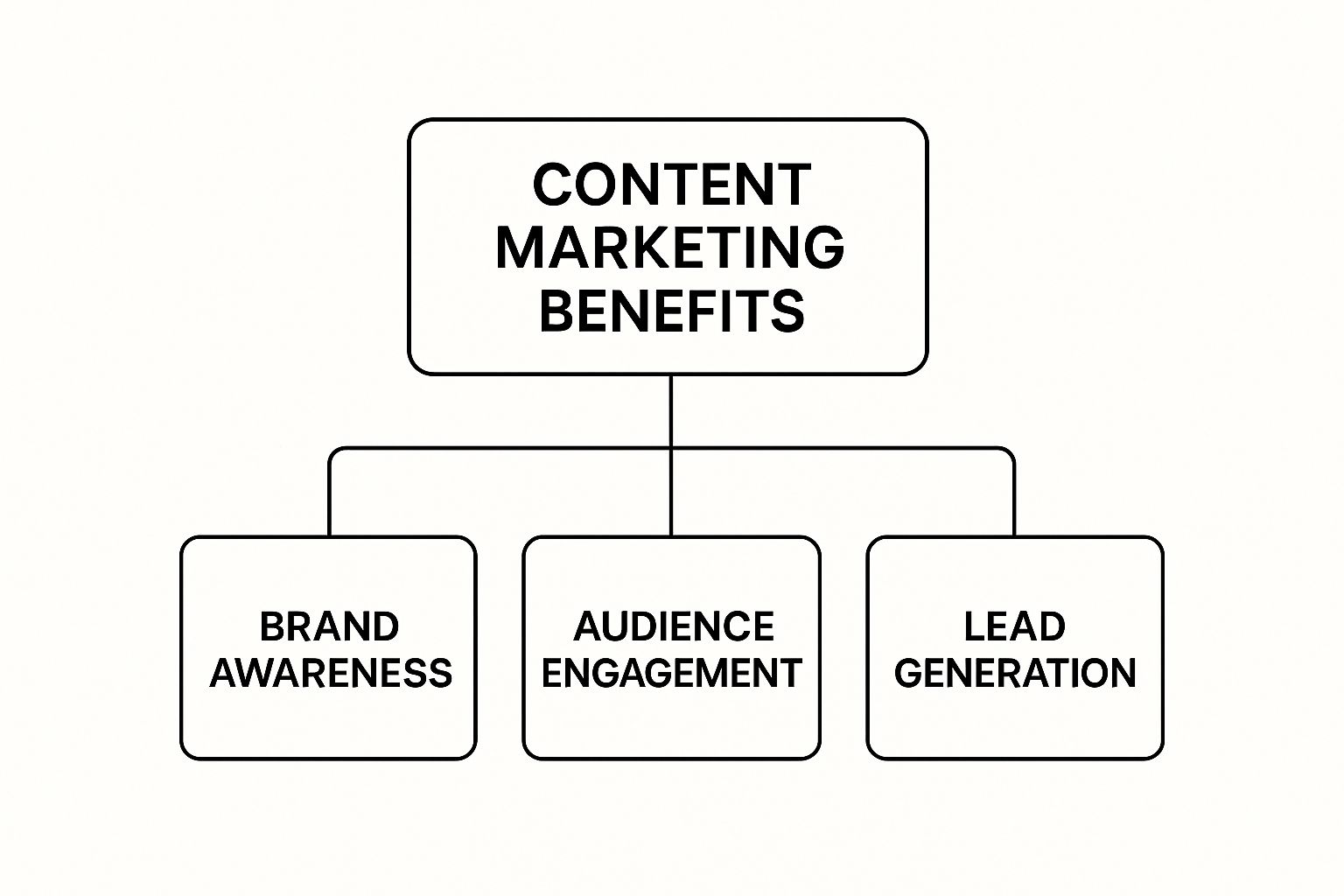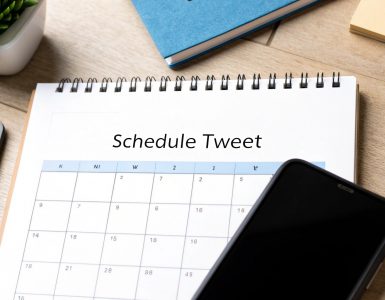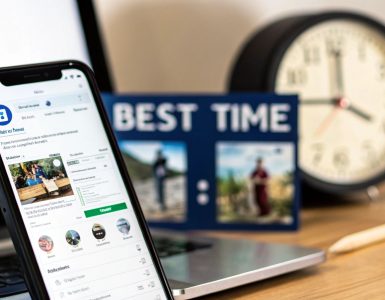Let’s start at the beginning. What exactly is a content marketing strategy?
Think of it as your North Star. It’s the high-level plan that guides every article you write, video you shoot, and social media post you share, all to hit very specific business goals. It's the essential why behind your content, forcing you to define who you're talking to and what you want to achieve before you create anything.
This strategic mindset is what separates intentional, predictable growth from just… making noise.
Beyond Random Acts of Content

It’s a common trap. A lot of businesses create content. They publish a blog post here, share a few updates there, but these actions are often disconnected, lacking a clear, unifying purpose. This is the classic difference between being busy and being truly effective.
A solid content marketing strategy changes the game. It transforms your efforts from a collection of one-off tactics into a cohesive, goal-driven machine.
Imagine a garage band just jamming versus a symphony orchestra performing a masterpiece. The orchestra has a conductor (your strategy) making sure every instrument (each piece of content) plays its part at precisely the right moment. The result? A powerful, unified experience for the audience. That’s what a strategy does for your marketing.
Strategy vs. Tactics: A Quick Comparison
It's incredibly easy to mix up strategy and tactics, but getting this right is non-negotiable. Your strategy is the long-term vision—the big picture. Tactics are the specific, concrete actions you take on the ground to bring that vision to life.
This table breaks down the difference:
| Aspect | Content Strategy (The Why) | Content Tactics (The What) |
|---|---|---|
| Focus | The high-level plan, goals, and audience. | Specific actions and content formats. |
| Timeframe | Long-term (Quarterly, Annually) | Short-term (Daily, Weekly) |
| Example | "Increase brand authority with our target audience of small business owners by creating expert-led educational content." | "Publish a weekly 'how-to' blog post, create a monthly expert interview video, and share daily tips on LinkedIn." |
See the connection? Without a strategy, your tactics are just a series of disjointed efforts that never build momentum. But without tactics, your brilliant strategy is just a document that sits on a shelf collecting dust. You need both to succeed.
Why Your Business Needs This Blueprint
In today's market, a documented content marketing strategy isn't a "nice-to-have"—it's a core business requirement. It’s the framework that ensures every dollar and every hour you invest in content creation delivers a measurable return. It forces you to define success upfront, whether that’s boosting brand awareness, generating qualified leads, or improving customer loyalty.
A great content strategy will attract and engage a target audience, meeting their needs while driving business goals. It’s the foundation that turns your marketing from an expense into a reliable growth engine.
This deliberate approach is precisely why its adoption is so widespread. In fact, nearly 84% of companies report having a defined content marketing strategy in place as of early 2025. You can discover more about these content marketing statistics to see just how critical this has become.
Ultimately, understanding what a content marketing strategy truly is marks the first step toward building a more intentional, predictable, and profitable marketing program.
The Four Pillars of a Winning Content Strategy
A powerful content marketing strategy isn't some monolithic, one-and-done document. It's more like a sturdy structure built on four essential pillars, each one supporting the others. If you neglect one, the whole thing gets wobbly and risks collapsing. Getting these right is how you graduate from just "making content" to actually engineering predictable business growth.
Think of it like building an archway. Every single stone has to be perfectly shaped and placed to support the weight of the others. Your strategy works the same way.
1. Deep Audience Insight
This is the bedrock. It’s where everything starts. And I don't mean a vague demographic like "males aged 25-40." True audience insight means you get what makes your ideal customer tick—their motivations, their biggest challenges, and the exact questions they’re typing into Google at each stage of their journey. You know what keeps them up at night and what a huge win looks like in their world.
This kind of insight isn't built on guesswork; it's built on data. This is where you create detailed buyer personas, which are essentially semi-fictional sketches of your ideal customer. They aren't just fantasy profiles; they're composites built from real-world information.
To get this right, you need to:
- Dig into your existing customer data: Look for common threads in job titles, industries, or company sizes.
- Talk to people: Interview your best customers. Grab coffee with your sales team. Find out what pain points come up in actual conversations.
- Be a fly on the wall: Lurk in the social media groups and forums where your audience hangs out. What questions are they asking in their own words?
Without this deep understanding, you're creating content in the dark, just hoping it connects with someone. With it, you can craft messages that feel personal, relevant, and genuinely helpful.
2. Mission-Driven Goals
Okay, so you know who you're talking to. Now you need to figure out why. Every single piece of content—every blog post, video, and tweet—needs a clear purpose that ties directly back to a measurable business objective. Random acts of content are a surefire way to drain your budget without moving the needle.
Your goals need to be specific and linked to Key Performance Indicators (KPIs). So, instead of a fuzzy goal like "get more traffic," a mission-driven goal sounds more like, "Increase organic blog traffic from marketing managers by 20% in Q3 to support our lead generation target." See the difference?
A strong content strategy connects every article, video, and social post to a concrete business outcome. It’s the framework that justifies your marketing budget and proves its ROI.
This infographic does a great job of showing how these efforts translate into core business benefits.

You can see how a single, focused strategy branches out to hit multiple, interconnected business goals, from simply getting new eyes on your brand to turning that initial interest into qualified leads.
3. The Content Creation Engine
With your audience and goals locked in, the next pillar is your system for producing high-quality content consistently. I call this the "content creation engine"—a reliable, repeatable process for brainstorming, creating, and polishing your content.
A well-oiled engine means you're never scrambling for ideas or sacrificing quality just to hit a deadline. It’s made up of a few key parts:
- Ideation: A system for capturing and developing content ideas based on keyword research, customer feedback, and what your competitors are doing.
- Content Calendar: Your roadmap. This schedule plans what gets published and when, ensuring you maintain a consistent rhythm.
- Production Workflows: Clearly defined steps and roles for who writes, edits, designs, and gives the final green light before anything goes live.
Building a reliable engine is non-negotiable. It allows your team to produce a mix of assets that serve different needs. For a little inspiration, it’s worth exploring the different types of content for a business blog you can create to pull in and hold your audience's attention.
4. Intelligent Distribution
Here’s a hard truth: creating great content is only half the battle. The final pillar is intelligent distribution. That amazing article or insightful video is completely worthless if your target audience never sees it. You need a proactive plan to get your content in front of the right eyeballs at the right time.
This means doing more than just hitting "publish" and hoping for the best. A smart distribution plan actively uses:
- SEO: Optimizing every piece of content so it shows up in search results when people are actively looking for answers.
- Social Media: Sharing your content on the platforms where your audience actually spends their time.
- Email Marketing: Nurturing your existing audience by sending valuable content straight to their inbox.
- Paid Promotion: Putting a little budget behind your top-performing content to amplify its reach and get it in front of a wider, yet targeted, audience.
Each pillar holds the others up. Your audience insight informs your goals. Your goals give your content engine a purpose. And your distribution plan makes sure the engine's output actually achieves that purpose. Put them all together, and you have the unshakable foundation of a strategy that drives real, measurable results.
How to Build Your Content Strategy from Scratch

Alright, let's get our hands dirty. Moving from theory to practice is where the real work begins. Building a content strategy from the ground up isn’t about throwing ideas at the wall to see what sticks; it's a methodical process. Think of it like a mechanic assembling a high-performance engine, where every single part has to work in perfect harmony to get you where you need to go.
The whole journey starts with an honest look at where you are right now and finishes with a crystal-clear map of where you're headed. Let’s walk through the essential steps to build a strategy that actually moves the needle.
Start With a Content and SEO Audit
Before you can map out your future, you need to understand your past. A content and SEO audit is your ground zero—a complete review of everything you've ever published. This isn’t just about making a list; it’s about putting your existing content under a microscope to see how it’s really performing.
The goal here is to figure out what's hitting the mark with your audience and what's collecting digital dust. Find your heavy hitters—the articles that bring in traffic, the social posts people love, the videos that get shared. Just as importantly, you need to identify the content that’s doing absolutely nothing for you.
This process gives you some incredibly valuable intel:
- Content Gaps: What are your competitors ranking for that you haven’t even talked about?
- Winning Formats: Do videos kill it for your audience, or do they prefer deep-dive guides?
- Outdated Content: Which old posts could be updated and republished for a quick win?
- Low-Hanging Fruit: Are there any articles lingering on page two of Google that just need a little nudge to hit page one?
An audit like this gives you a data-backed foundation, swapping out guesswork for hard facts about what actually works for your audience.
Define Your SMART Goals
Okay, your audit told you where you stand. Now, where are you going? Fuzzy goals like "get more traffic" are useless because you can't measure them. This is where SMART goals come in: Specific, Measurable, Achievable, Relevant, and Time-bound.
This simple framework turns a vague wish into a concrete target.
A SMART goal isn't "We want to grow our blog." It's "We will increase organic blog traffic by 25% in the next six months by publishing two new, keyword-focused articles every week."
Defining your goals this way forces you to be specific and gives you a clear finish line. It's the difference between wandering aimlessly in the woods and following a well-marked trail to a specific viewpoint.
Conduct Deep Keyword and Topic Research
You have your goals, but what content will get you there? This is where keyword and topic research becomes your best friend. It’s all about digging in to find the exact words, phrases, and questions your ideal customers are typing into search engines.
But it’s not just about chasing keywords with high search volume. The real magic happens when you identify topics that match what your audience needs at every step of their journey, from just becoming aware of a problem to being ready to buy. This is how you build topic clusters—groups of interlinked articles that cover a core subject from every angle.
As you start piecing together your content plan, looking at different industries can be a great source of inspiration. For instance, checking out powerful marketing strategies for content used by authors can spark fresh ideas, no matter your niche. The objective is to create a web of helpful content that positions you as the go-to expert.
Plan Your Content Calendar and Workflow
Great ideas are just that—ideas. Execution is everything. A content calendar is the tool that turns your grand strategy into a day-to-day action plan. It lays out exactly what you're publishing, where it's going, and when.
Think of it as more than just a calendar; it’s your production pipeline. Tools like Asana, Trello, or even a detailed spreadsheet can help you map out every step:
- Ideation: Assigning a topic.
- Drafting: Setting the first draft deadline.
- Review: Scheduling time for edits and approvals.
- Design: Blocking out time for graphics and visuals.
- Scheduling: Locking in the publication date.
- Promotion: Planning the rollout across email, social media, and other channels.
This systematic workflow prevents the last-minute scramble and ensures you're putting out high-quality content, consistently. If you want to go deeper, our guide on how to create a marketing calendar for your blog provides a detailed walkthrough. A well-oiled workflow is the engine that keeps your strategy running; without it, the best ideas will simply stall out.
Measuring What Matters with Content KPIs
Great content is a start, but it's not the finish line. If you’re not measuring its performance, you’re basically navigating in the dark. You won't know what's connecting with your audience, what’s falling flat, or where your best opportunities for growth are hiding. This is where Key Performance Indicators (KPIs) come in—they are the compass for your content marketing strategy.
But let's be clear: this isn't about chasing empty "vanity metrics" like a random jump in social media followers. It's about connecting specific data points directly to your business goals. The trick is to pick the KPIs that actually tell you if you're getting closer to what you want to achieve.
KPIs For Brand Awareness
When your main objective is just getting your name out there, your KPIs should all be about reach and visibility. You’re trying to answer one simple question: "Are more of the right people finding us?"
- Organic Traffic: This is the lifeblood of many content strategies. It's the number of people who find your site through a search engine like Google. A healthy, growing stream of organic traffic means your SEO and content are hitting the mark.
- Keyword Rankings: Are you showing up on the first page for the search terms that matter to your business? Tracking your rank for key phrases shows if you're becoming a visible authority in your niche.
- Social Media Reach: This tells you the total number of unique people who laid eyes on your content across social platforms. It’s a straightforward measure of how far your message is traveling.
KPIs For Audience Engagement
So, people have found you. Great! But are they sticking around? Engagement KPIs tell you whether your content is truly hitting home. Strong engagement is the best sign that you're delivering real value, not just baiting clicks.
Think of it like throwing a party. It's not just about how many people RSVP (awareness); it's about whether they hang around, chat with others, and actually enjoy themselves (engagement).
High engagement is the proof in the pudding. It shows your content isn’t just being seen—it's being actively consumed and appreciated. This is how you build a loyal community that genuinely trusts what you have to say.
Here are the metrics that tell this story:
- Time on Page: The average time someone spends on a single page. If people are spending several minutes reading your blog post, you know you’ve captured their attention.
- Scroll Depth: This tracks how far down a page people are actually scrolling. It’s a fantastic way to see if they’re reading your whole article or just glancing at the title and bailing.
- Comments and Shares: These actions are pure gold. When someone takes the time to leave a comment or share your work, it means your content sparked a real reaction.
KPIs For Lead Generation And Sales
At the end of the day, most businesses need content to help drive revenue. This is where your strategy gets serious, directly connecting your articles, videos, and guides to the bottom line. These KPIs are absolutely essential for proving the return on your investment (ROI).
Don't underestimate the financial power of content marketing. The global market size was a staggering $413.2 billion in 2022 and is on track to smash $2 trillion by 2032. You can read more about these content marketing trends to see just how critical lead generation is to this explosive growth.
To measure your impact here, focus on:
- Conversion Rate: This is the percentage of visitors who take a specific, desired action—like downloading a guide, signing up for a webinar, or filling out a contact form. It’s the clearest measure of how well your content persuades people to take the next step.
- Content-Attributed Revenue: With tools like Google Analytics 4, you can often connect the dots and see which blog posts or videos a customer viewed before making a purchase. This allows you to directly link sales back to specific pieces of content.
Mapping Business Goals to Key Performance Indicators
Connecting your high-level business objectives to the right metrics is the key to a strategy that actually works. This table provides a simple framework to help you bridge that gap, ensuring you're always tracking what matters most.
| Business Goal | Primary KPI | Secondary KPIs |
|---|---|---|
| Increase Brand Awareness | Organic Traffic Growth | Keyword Rankings, Social Media Reach |
| Build Audience Engagement | Time on Page | Scroll Depth, Comments, Social Shares |
| Generate Qualified Leads | Conversion Rate (e.g., Form Fills) | Cost Per Lead (CPL), Number of New Leads |
| Drive Sales & Revenue | Content-Attributed Revenue | Customer Lifetime Value (CLV), ROI |
This mapping process gives you the clarity you need to refine your strategy, prove its value to stakeholders, and make smart, data-informed decisions. It transforms measurement from a chore into your most powerful tool for growth.
For a much deeper dive into the tools and techniques for tracking all of this, check out our complete guide to content marketing analytics.
How to Evolve and Scale Your Strategy
A great content marketing strategy is never truly finished. It’s a living plan that needs to adapt and grow right along with your business. Think of it less like a static blueprint and more like tending to a garden. You can’t just plant the seeds and walk away expecting a miracle. You have to constantly nurture it—pruning what isn't working, feeding what is, and planting new seeds to keep it all thriving.
This ongoing process of evolution and scaling is what separates the merely good strategies from the truly great ones. It’s how you ensure your marketing efforts stay effective, relevant, and perfectly aligned with your business goals for the long haul.

Use Data to Constantly Optimize Performance
Your analytics dashboard is your secret weapon for growth. Regularly digging into performance data isn’t just about checking a box; it’s about uncovering clear, actionable opportunities for improvement. The numbers tell a story about what your audience genuinely responds to, letting you guide your next moves with facts instead of just gut feelings.
Start by zeroing in on a few key optimization tactics:
- A/B Test Your Headlines: Your headline is often the single most important factor in getting someone to click. A tiny tweak can lead to a massive difference in engagement. Test different styles—questions versus statements, using numbers versus not—to find out what truly grabs your audience's attention.
- Systematically Update Old Content: Don't let good content go to waste. Go back through your archives and find those blog posts that were moderately successful but could use a refresh. Can you add new information, update some stats, or embed a relevant video? Republishing this updated content can breathe new life into it and give you a nice SEO boost.
- Fuel New Ideas with Insights: Your best-performing content is a goldmine of future ideas. If a guide on "social media scheduling" is a runaway hit, that’s a loud and clear signal from your audience. Use that insight to create related content, like a follow-up video on "advanced scheduling techniques" or a downloadable "social media calendar" template.
An evolving content strategy listens to the data. Every click, share, and comment is a piece of feedback from your audience. Use this feedback loop to refine your approach and deliver more of what they love.
This commitment to data-driven improvement is precisely why smart marketers are doubling down on their investments.
Scale Your Production Without Sacrificing Quality
As your strategy starts paying off, the demand for more content will naturally grow. Scaling your production is the logical next step, but it comes with a major risk: letting your quality slip. The key is to grow your output thoughtfully and strategically.
There are a few solid ways to scale your content engine:
- Build an In-House Team: If content is at the heart of your business, hiring dedicated writers, videographers, and designers gives you the most control and ensures brand consistency.
- Work with Freelancers and Agencies: Tapping into a network of specialized freelancers or partnering with a content agency gives you access to expert talent without the overhead of full-time staff. It’s a flexible way to scale up or down as your needs change.
- Leverage AI for Efficiency: AI tools can be incredible assistants. Use them to brainstorm ideas, whip up first drafts, or optimize existing content for SEO. The trick is to use AI to augment your team’s creativity, not to replace their critical thinking and expertise.
No matter which path you take, maintaining a strict quality control process is non-negotiable. Your brand's reputation is built on the value and reliability of your content. Don't ever compromise that for the sake of quantity.
This forward-looking approach is reflected in how businesses are planning their budgets. Looking ahead to 2025, 46% of B2B marketers expect to increase their content marketing budgets. Their spending priorities show a clear focus on high-impact formats and tech, with 61% planning to boost spending on video, 52% on thought leadership, and around 40% on AI-driven content tools. If you want to see where the industry is headed, you can explore more insights on future content marketing statistics.
Ultimately, a successful content strategy is a living, breathing part of your business. By regularly checking your performance, optimizing your approach, and scaling production with care, you’ll build a powerful and sustainable engine for growth.
Answering Your Content Strategy Questions
Once you get the hang of the big picture, the practical questions always start to bubble up. It's one thing to understand the theory, but another to actually put it to work. Let's tackle some of the most common questions I hear from people who are ready to move from planning to doing.
These are the real-world details that separate a plan on a whiteboard from a system that actually gets results.
How Often Should I Update My Content Marketing Strategy?
Think of your strategy as a living, breathing guide, not something carved in stone. You'll want to do a major, deep-dive review once a year. This is your chance to step back and align your content with any new business goals, shifts in the market, or big-picture changes you're planning for the year ahead.
But don't just file it away for 12 months. You need to be more agile than that.
That's why you should also schedule tactical check-ins every quarter. During these quarterly reviews, you'll dig into your KPIs and see what's working and what's not. Is a new video format suddenly crushing it? Did a competitor just launch a major campaign you need to react to? This is when you make those course corrections to stay sharp.
So, it's a combination: one big strategic overhaul annually, with nimble adjustments every quarter.
What’s the Difference Between a Content Strategy and an Editorial Calendar?
This is a classic point of confusion, but it’s actually pretty simple when you look at it this way.
- Your Content Strategy is the high-level "WHY." It answers the big questions: Who are we talking to? What do we want to achieve with our content? What are our core topics and brand voice? It's the master blueprint for your entire operation.
- Your Editorial Calendar is the ground-level "WHAT" and "WHEN." This is the hands-on schedule of specific blog posts, videos, social media updates, and newsletters. It's the tool that brings your strategy to life every single day.
Your strategy is the North Star that guides every decision you make. Your calendar is the roadmap you use to execute the journey. Without a strategy, your calendar is just a list of random stuff. With one, it becomes a powerful system for hitting your goals.
In short, the strategy sets the direction, and the calendar manages the daily execution.
How Much Should a Small Business Budget for Content Marketing?
There’s no magic number here, but a good rule of thumb is to set aside 10-25% of your total marketing budget for content. Now, for a brand-new small business, that "budget" might be less about cash and more about your own time and sweat equity, and that’s perfectly fine.
The trick is to start small and prove it works.
Focus on creating just a few fantastic, high-impact pieces of content. Track their performance like a hawk to show a clear return on your investment (ROI). Once you can confidently say, "This article generated 15 new leads," it becomes much easier to justify reinvesting those wins back into your content. You can then scale up by hiring a freelancer, buying better tools, or putting money behind paid promotion to get your best work in front of more people.
Can I Do Content Marketing Without a Blog?
Absolutely. A blog can be an incredible engine for long-term SEO and a central hub for your brand, but it's not the only game in town. The best content format is simply the one your audience already uses and enjoys.
Your strategy should lead you to the right channel, not the other way around. Think about it:
- If your audience is full of busy professionals, a podcast they can listen to on their commute could be the perfect fit.
- If you're in a highly visual space like fashion, food, or design, a strategy centered on Instagram and YouTube will likely outperform a text-heavy blog.
- If you're trying to reach a B2B audience, a smart, focused LinkedIn newsletter might be your most direct path to their inbox.
Remember the process: Your content strategy first helps you figure out the "who" (your audience) and the "why" (your goals). Only then can it show you the most effective "what" and "where"—whether that's a blog or something else entirely.
Ready to put your evergreen content on autopilot and save hours every week? EvergreenFeed integrates seamlessly with Buffer to automatically schedule and post your best content, keeping your social media channels active and engaging without the manual grind. Start your free trial today and see the difference.




